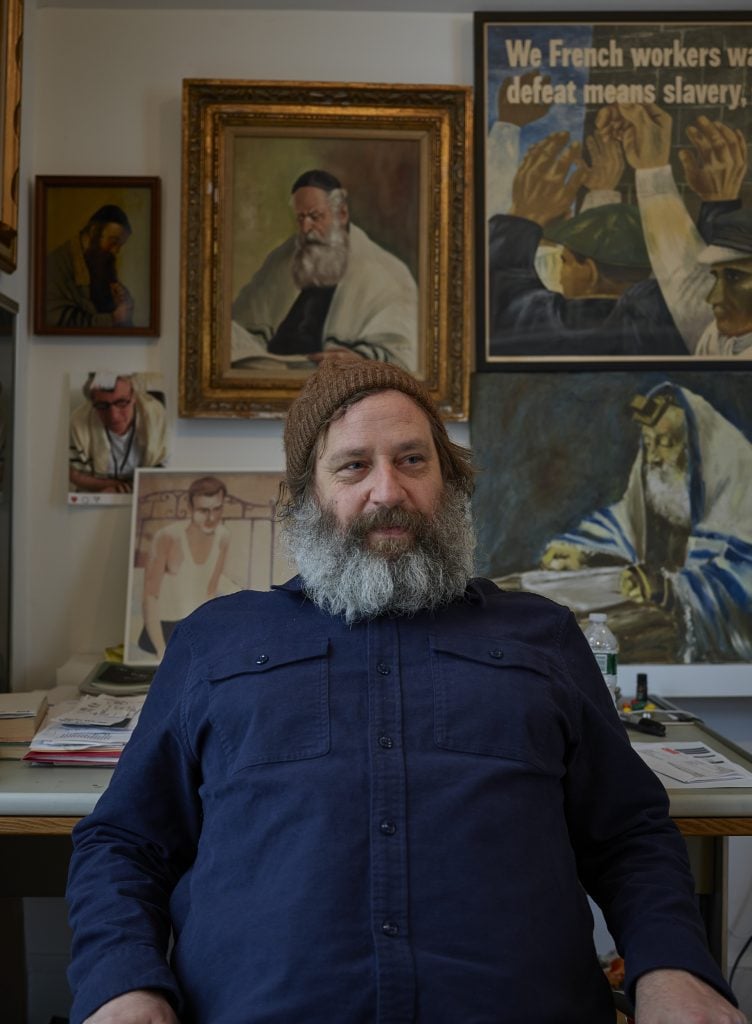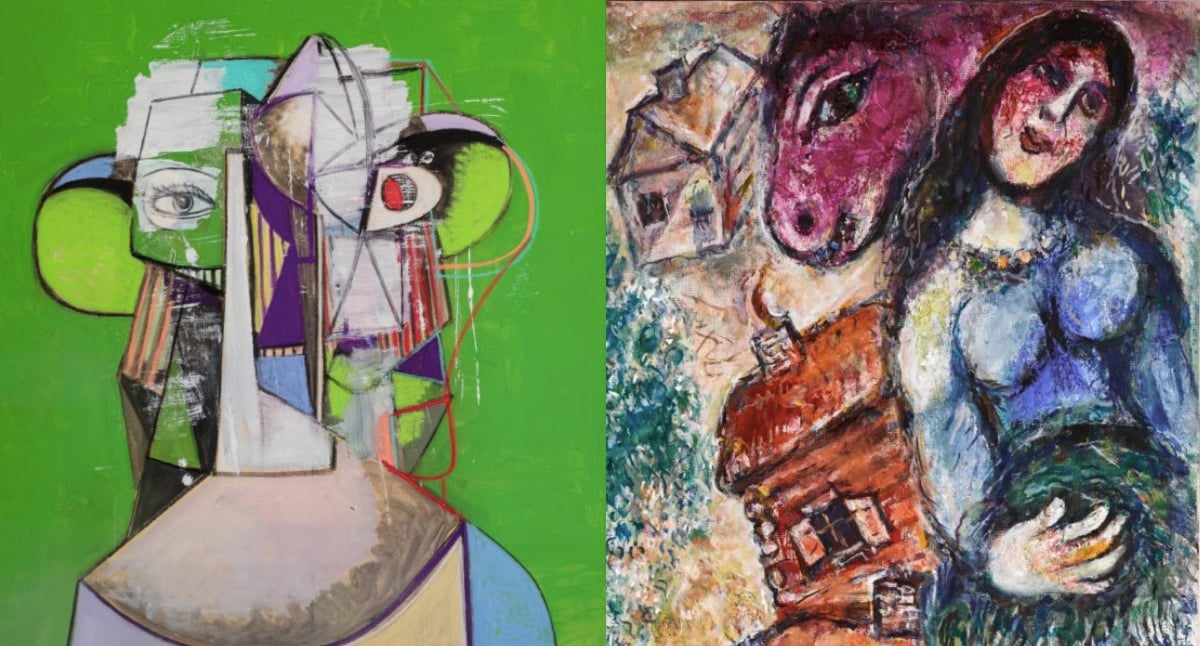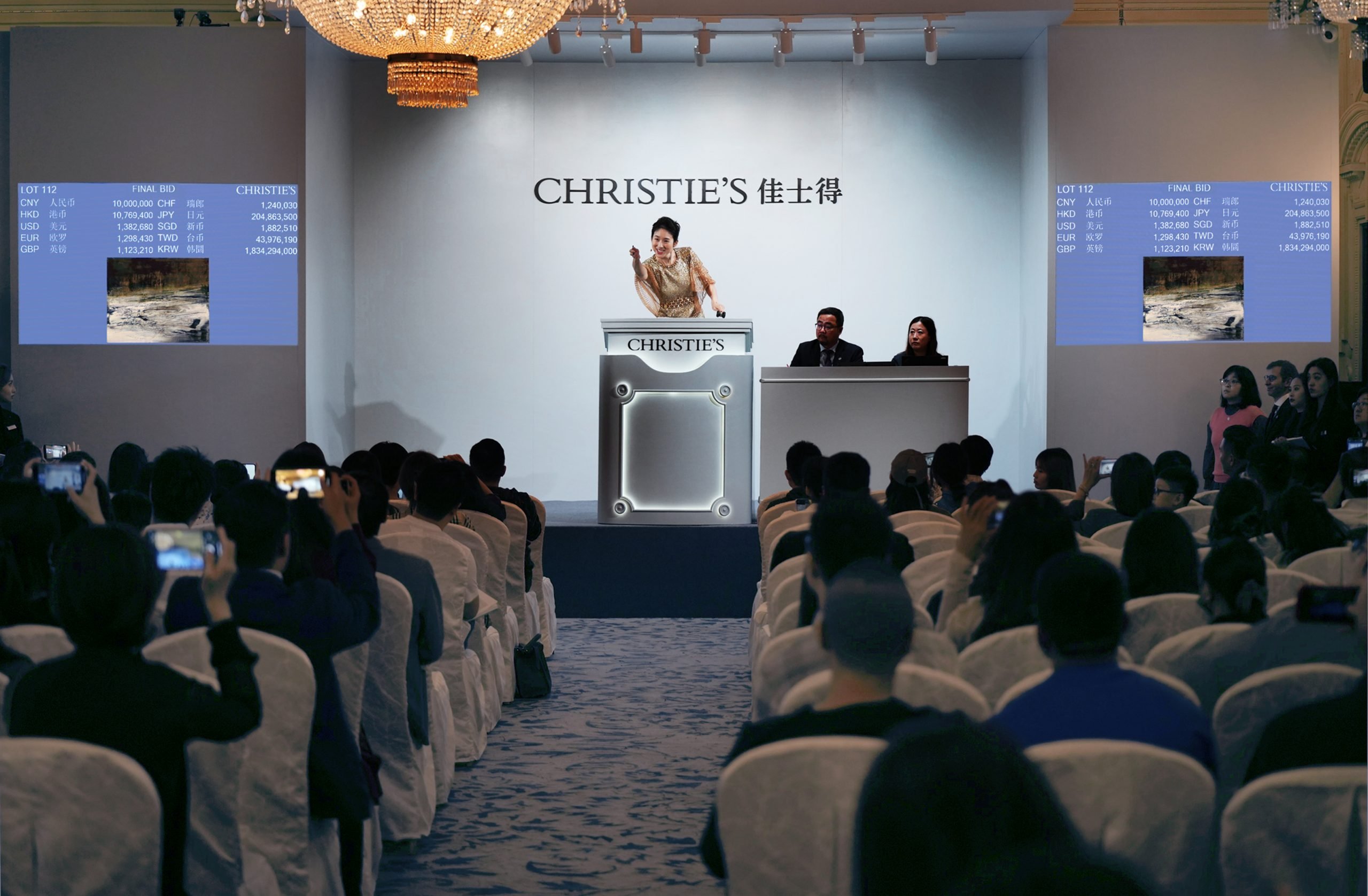It’s not easy to make a living as an art dealer, but Joel Mesler managed to do it for almost two decades. A prodigious talent scout who set up shop in Los Angeles and then New York, he gave early opportunities to artists including Loie Hollowell, Rashid Johnson, and Henry Taylor. Ever the entrepreneur, he maintained side hustles in real estate (Mesler was dealer David Kordansky’s first landlord in Los Angeles) and developed an innovative pop-up model called Rental Gallery, which pre-dated gallery-share initiatives like Condo by nearly decade.
For much of that time, Mesler was maintaining yet another side hustle behind the scenes—as a painter. What began in 2015 as a hobby has now officially eclipsed his day job, with lighthearted paintings of slogans in front of lush backgrounds making waves at blue-chip galleries and major auction houses.
To date, Mesler has had shows at London’s Simon Lee; Los Angeles’s David Kordansky; and most recently, at Lévy Gorvy’s outpost in Hong Kong, where new paintings are on view through August 14th. Meanwhile, his works have soared at auction, peaking at $275,000 at Christie’s New York in May.
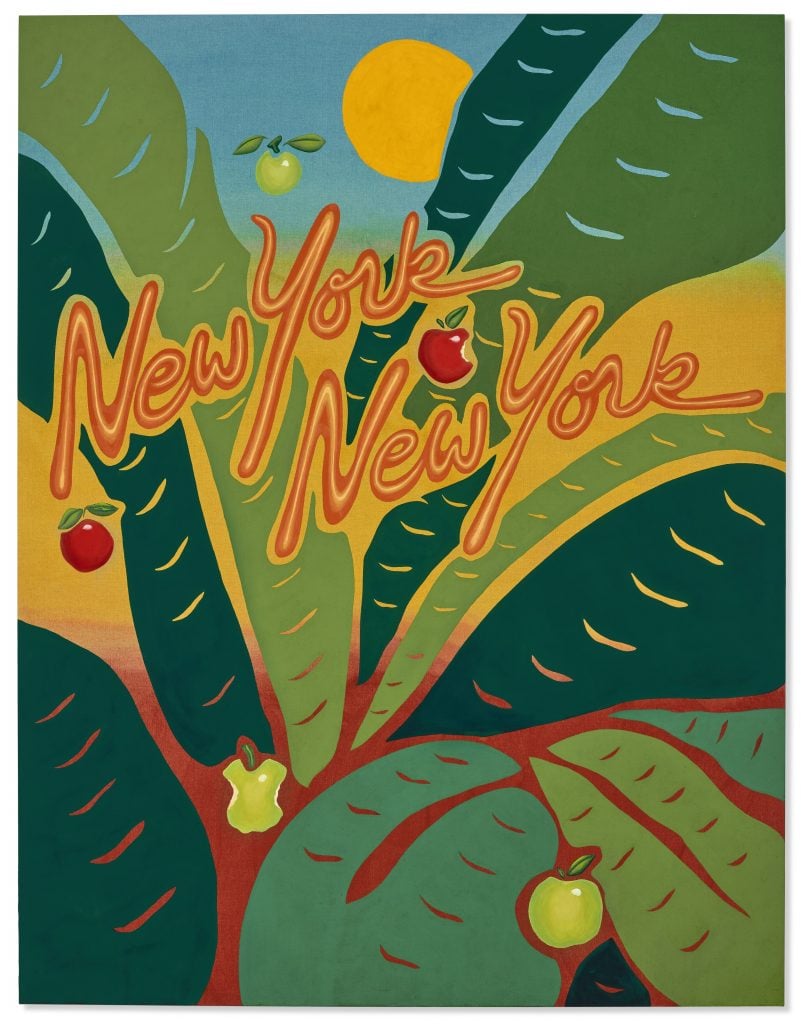
Joel Mesler, New York, New York (2021). Courtesy of Christie’s Images, Ltd.
Mesler’s ascent has been rapid. In February 2017, collector Niels Kantor sold his paintings out of his Beverly Hills home for just $4,000. Later that year, the nascent painter presented his own works at NADA Miami, where they sold out. Mesler’s big break came less than a year later, when Simon Lee gave him a show in spring 2018 and sold an impressive 22 paintings for $12,000 each.
In March 2020, book dealer and sometimes gallerist Harper Levine, of Harper’s Books, sold out a show of canvases priced at $18,000 and 33 works on paper priced at $2,200. And in January of this year, Mesler made a triumphant return to Los Angeles, where David Kordansky offered paintings by his former landlord in the mid-five-figure range.
Prices rose once again for the current Lévy Gorvy show, with the triptychs priced at $350,000; larger paintings priced at $120,000, and midsize works priced at $80,000. That’s a 900 percent increase in just three years. (The show was sold out within two days of opening, with every work but two sold to Asian museums, foundations, and private collectors.)
Notably, while the market has gobbled up Mesler’s paintings at breakneck speed, institutions and critics have been silent about his colorful pop-saturated canvases.
So what happens when an art dealer becomes a white-hot emerging artist at middle age? We spoke to Mesler about experiencing success as both a dealer and artist, how one career informed the other, and why he’s no longer afraid of failure.
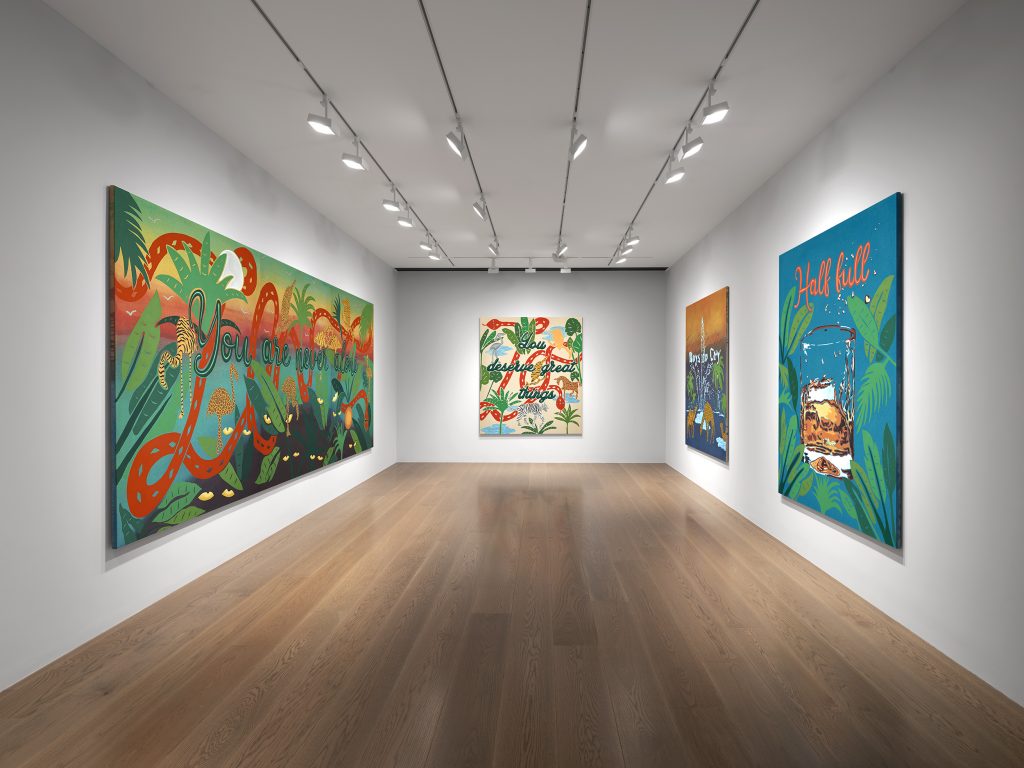
Installation view, “Joel Mesler: In the Beginning” at Levy Gorvy. Photo: Kitmin Lee, courtesy of Levy Gorvy.
Your story starts in Chinatown, in L.A. What was the art scene like there in the early aughts?
I went to San Francisco Art Institute for grad school, and after I graduated, my friends started to get exhibitions. But my studio was a ghost town—there was tumbleweed in there, I could not sell a painting or get in a group show to save my life. Granted, I was making terrible art at the time. So I moved back to Los Angeles, where I’m from.
At the time, every single building on Chung King Road [in Chinatown] was either for sale or for lease, and the rent was like $1,400 a month, but the buildings were on the market for $240,000. I realized that buying a building would actually be cheaper than renting it, so my mother loaned me $30,000 and I bought the building and rented the apartment upstairs to [artist] Frances Stark and Steve Hanson [who ran the gallery China Art Objects] for $1,200 while my mortgage was like $1,100 a month, so I was making $100.
I moved into the basement, where I also had my studio, and I opened a gallery on the ground floor with almost no overhead. Even though I didn’t know what I was doing, I knew a lot of artists and I remember feeling like I made it when I sold a painting for $4,000 after my third or fourth show. So I put down my paint brushes, became a full-time dealer, and spent all my earnings at the bar across the street.
You then moved to New York to open a pop-up space called Rental Gallery.
At that time, in 2006, European dealers would come to the U.S. looking for a space to show their artists, and rather than showing their artists with a local gallery and only making 15 percent, I said, “Why don’t you rent my space to show your art, pay my overhead and my assistant, and give me the 15 percent commission and you keep 35 percent?” People like Patricia Low, Christian Nagel, or Raster Gallery would show their artists at my space, and I would try to squeeze some shekels out of them. It paid my rent and made my way in the city, but there was a ceiling.
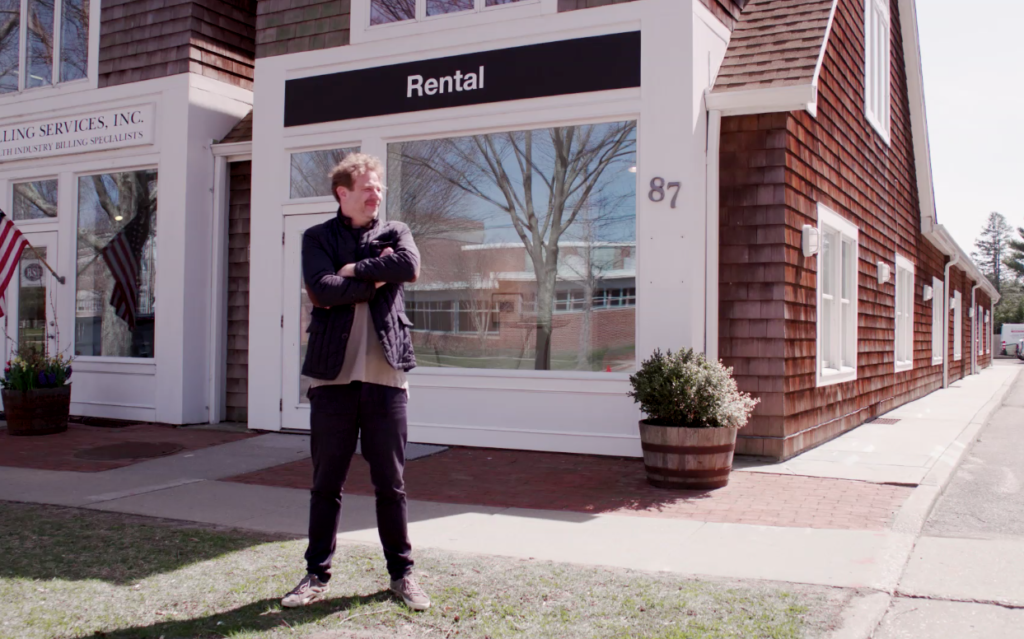
The artist and dealer Joel Mesler outside his East Hampton incarnation of Rental Gallery.
So you gradually transitioned to representing artists. Who were you showing at the time, and how did it transform your business?
I was interacting with so many artists by doing the Rental model that it was an organic transition. I hosted a show with L.A.’s Sister Gallery, run by my friend Katie Brennan, who showed Henry Taylor, and I remember they got into a really awful fight at the dinner after. Henry and I were already very close and I was selling his work quite a bit. After the fight, he came to me and he said, “I’m done, I’m done, I need a new Dundee, will you be my new Dundee?” And I was like, “I will be your Dundee!” And from that point on, I started representing artists. It was time to take this thing more seriously and get more professional.
I started working with Henry Taylor in 2009, showed Rashid Johnson, and represented Matthew Chambers, Brendan Fowler, Ry Rocklen, and a lot of Los Angeles artists. I decided not to have 20 artists on my roster, but work with the ones I had a very close relationship with. I was doing well, doing fairs like the Armory Show, and I was selling a lot of work.
In 2010, I partnered with Carol Cohen, who was Jay Jopling’s curator, to open Untitled. I decided I needed to open up a more professional gallery and needed somebody who was the complete opposite to me. So we opened up a space on the corner of 30 Orchard Street, which lasted until 2014.
A year later, I partnered with Zach Feuer. We were doing a lot of secondary deals together, and I think at that moment, both Zach and I wanted to take a step back, so we partnered thinking we would help the other one out, but in retrospect, I think we ended up slowing each other down. We went our separate ways two years later.
The first time that I remember seeing your work was in 2017, when you showed your own paintings at a booth at NADA Miami.
[NADA director] Heather Hubbs was one of the first people I met in New York, and she encouraged me to apply to NADA. I’d done the fair before but I was in a very precarious situation, having just moved to the Hamptons. I didn’t have a group of artists that would work. I thought, “Well, you know, I’m making paintings in my basement,” so I asked her if I could apply with my own paintings, and she said I could probably get away with it. So that’s what I did.
They stuck me in the back corner of the fair, but they let me in. By the second day, I had sold all of my own paintings and remember complaining to [art publicist] Adam Abdalla about not having anything to do for the remaining four days, and he was like, “Why don’t you just paint people’s portraits?” So I went to the art store to buy materials and charged people $250 for portraits, which was the start of the portrait project. I think I sold every canvas I bought from the art store.
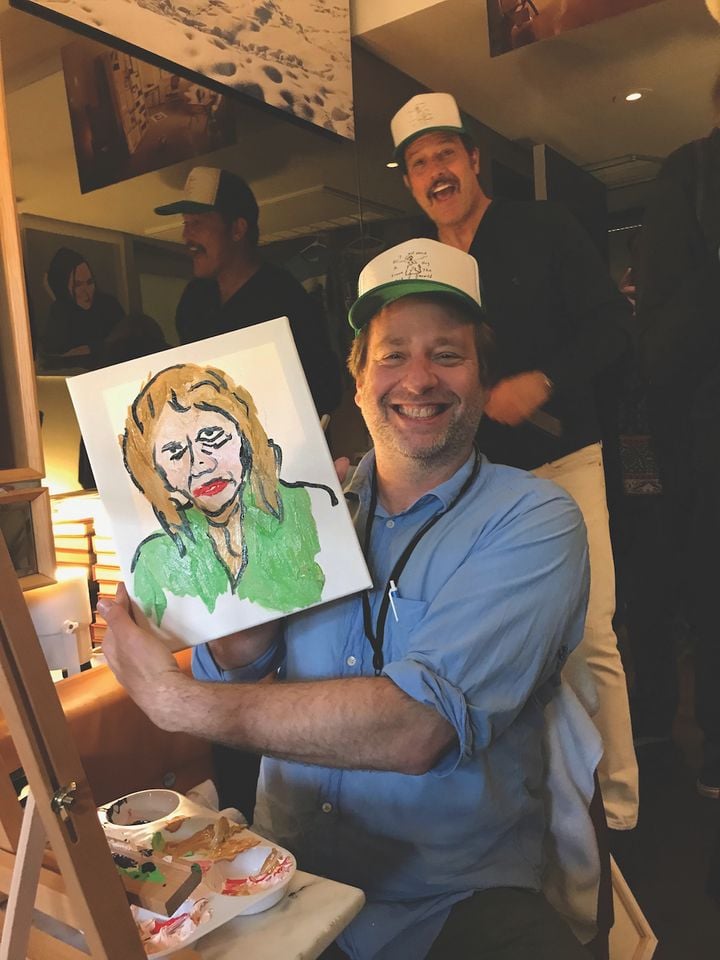
Joel Mesler. Photo: Jane Wesman and courtesy of Cultural Counsel.
What prompted the move to the Hamptons in 2017? Is that what opened the door for you to transition to a full-time career as an artist?
My career as an art dealer in New York City was naturally coming to a head. I was in severe, deep alcoholism, active alcoholism, and I knew I had to leave since I had three young children, but I didn’t know where to go. My wife and I were considering Philadelphia, or maybe moving back to Los Angeles. We stayed at Rashid Johnson’s place in the Hamptons for a week and saw more friends from New York City during our visit than we had seen in about two years. During that trip, my wife and I found a little saltbox house and bought it. Once we moved, I found a place for Rental Gallery. The space was next to Harper Levine [proprietor of Harper’s Books], who I had known in the city and played poker with. I thought this could be my new life. I knew I had to reinvent myself; the old me was dead.
How did that reinvention occur?
When I had my children, I started drawing again, and over time I moved to painting again. I wasn’t doing it for any reason other than just to do it. I really didn’t have a plan to show the works or even tell people. I think that helped contribute to why this time was a little different.
What about your experience as a dealer made you feel prepared to re-enter the art world as an artist? And were there any choices that you made about your art career that were informed by the specific experiences you had as a dealer or pitfalls that you were able to avoid?
I’ve seen a lot. I’ve seen so many waves as an art dealer, and I have seen how the decisions artists made really hurt them. Whether it be too much or too little, fear or ego—so many factors can contribute to problems.
When I started to get a little attention for my work, it was really important to pick a few people that I really trusted, put my faith in them, and let go a little bit. Because I spent my entire life not being desired as an artist, to have somebody want what I’m making was very new and different.
When I was younger, I would be very reactive—like Woody Allen said, you don’t want to be part of any club that would accept you as a member. I would almost question people when they liked me, but now I just thank them and I’m grateful for them. I’ve had an amazing past few years as a practicing artist. If it all went away tomorrow, that would be okay with me because I had fucking great time, and I feel like I made some great art. I’ve chosen an authentic path, and I’m not making decisions based on the fear that it could end my career. As long as I’m being honest with myself and making paintings that I want to make, I feel good.
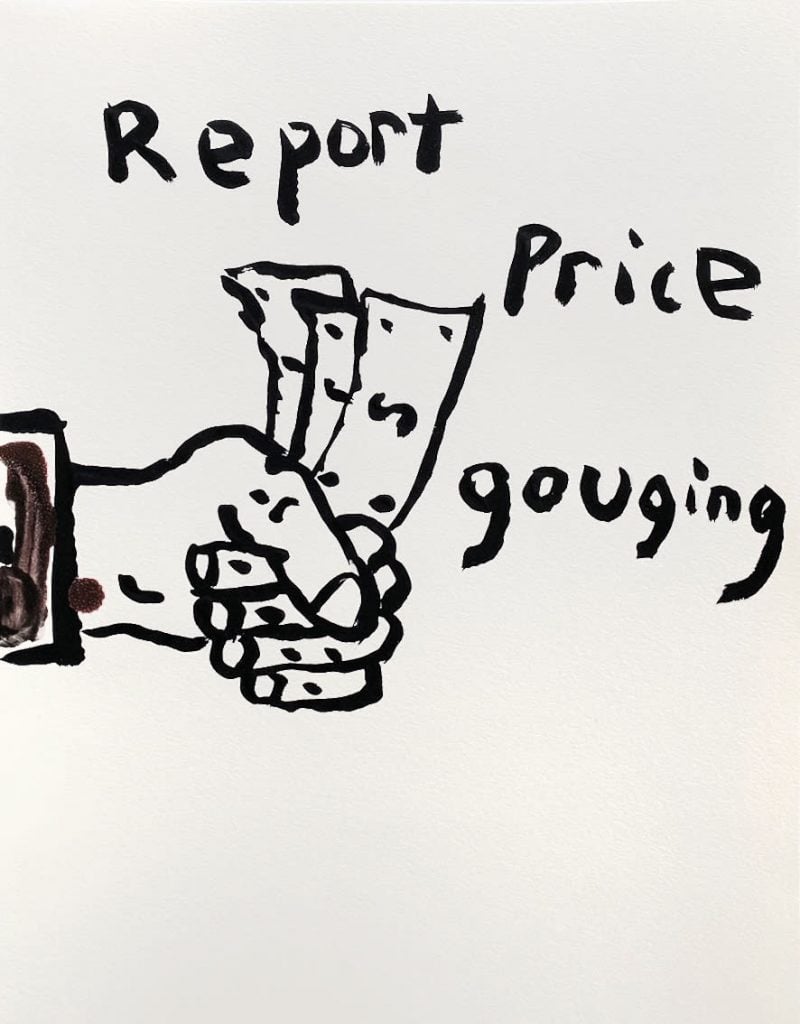
Joel Mesler, Untitled (2020). Courtesy of Unit London.
Next, you did a flurry of exhibitions and shows with different small spaces, like Niels Kantor’s home gallery and Gagosian director Adam Cohen’s A Hug from the Art World. Forgive me for this question, but what was it like to be an emerging artist as a middle-aged man?
I couldn’t believe my fortune. Selling paintings for $4,000 while my friends were selling paintings for $100,000 would have discouraged a younger version of myself. But at this stage in my life, I thought it was the greatest thing ever. I took those $2,000 and celebrated like I’ve never celebrated before. It was a really innocent time because I didn’t know if this would be the last summer I got to paint, and again, I was painting in my basement. If people came into the gallery, I would put my brushes down and run upstairs and sell other people’s art.
I remember saying to my wife, “I just sold like four paintings, do you think maybe I should do this full time?” And I remember her saying, “No way, we can’t afford for you to not be an art dealer.” At no point until very recently was this even an option. I thought I would paint in the off season. This summer, I’m using the gallery as my studio as opposed to opening for the summer and doing my normal three-to-four shows a year.
What did your paintings cost in your earlier shows? And to what extent did you play a role in determining the pricing?
In 2017, when I showed my paintings with Niels [Kantor], the idea was to just get the work out and let people experience it. I was selling my paintings for $4,000. When I showed at NADA, I think they were $6,000, maybe $8,000—definitely affordable. For pricing stuff, I’ve listened to other people and I’ve trusted them. I’m now in a territory that I’m unfamiliar with, so it’s important for me to recognize that, realize that this isn’t my expertise, and give over that control a little bit.
But with the portraits and printmaking, I liked the idea that as expensive as the work may get, people can afford it and live with it. I was asked to do the portraits at another location and they wanted me to double the prices, and I said absolutely not. They will always be $250 no matter what—that’s important to me.
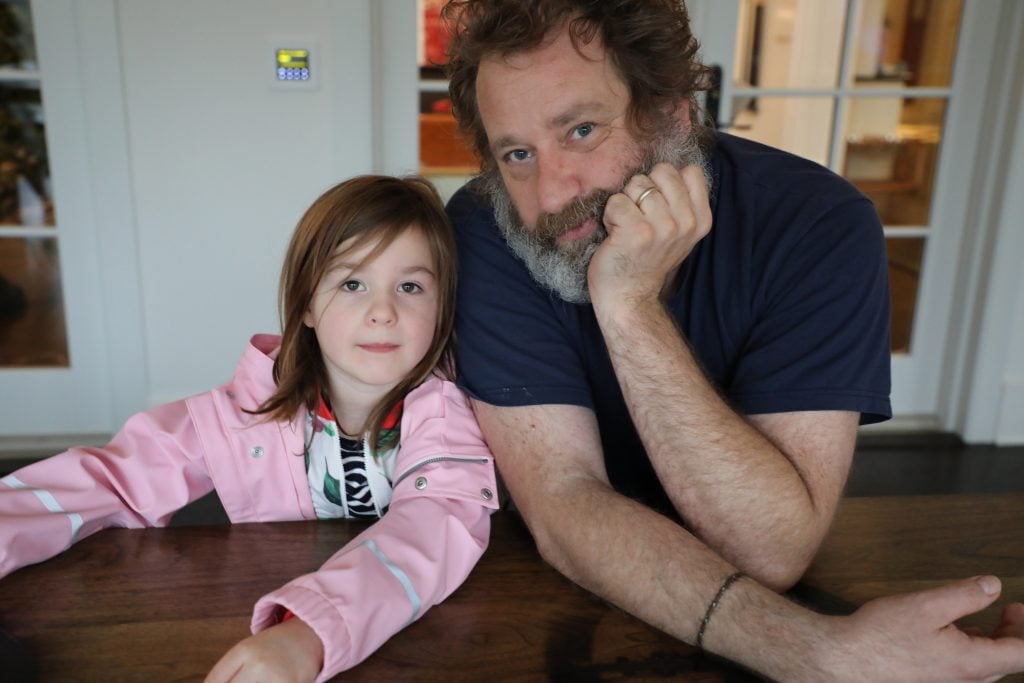
An elder Mesler with his gallery assistant in 2020. Photo: Sheree Hovsepian.
With the Simon Lee exhibition in London, things took off in earnest, and the Kordansky show brought your career into the next dimension. What was the price development between these shows?
The Simon Lee show was the first time people following me were like “Oh, that’s a real gallery, this guy’s showing in a real gallery.” Works were $12,000. [For the show,] I connected the alphabet to streets that I was familiar with in Los Angeles that were meaningful to me. Simon sold the [entire] alphabet [series] and I could not believe it—it was incredible.
You sold 26 paintings?
Yeah, although I kept three and I gave Simon “S” for Simon says. But when I did the exhibition with David Kordansky, people that were aware of me realized that Dave is taking it seriously. They realized that this is legitimate, and people really started to look at the paintings more closely. I don’t want to get into pricing beyond that.
How did you handle this increased interest?
I’m not somebody that normally talks to a lot of people throughout the day. I talked to my family, I talked to Rashid, who has a studio right next door to me. But I’ve been getting a lot more phone calls and texts, and I’ve had to learn to keep my phone on silent while I paint. Other than that, not much has changed.
Do you offer your dealers any parameters or have conversations about who they should or shouldn’t sell to?
I really embraced what they have to say about the content, the market, and the placement. We’re in uncharted territory for me. I know when to give up control, and that has happened.
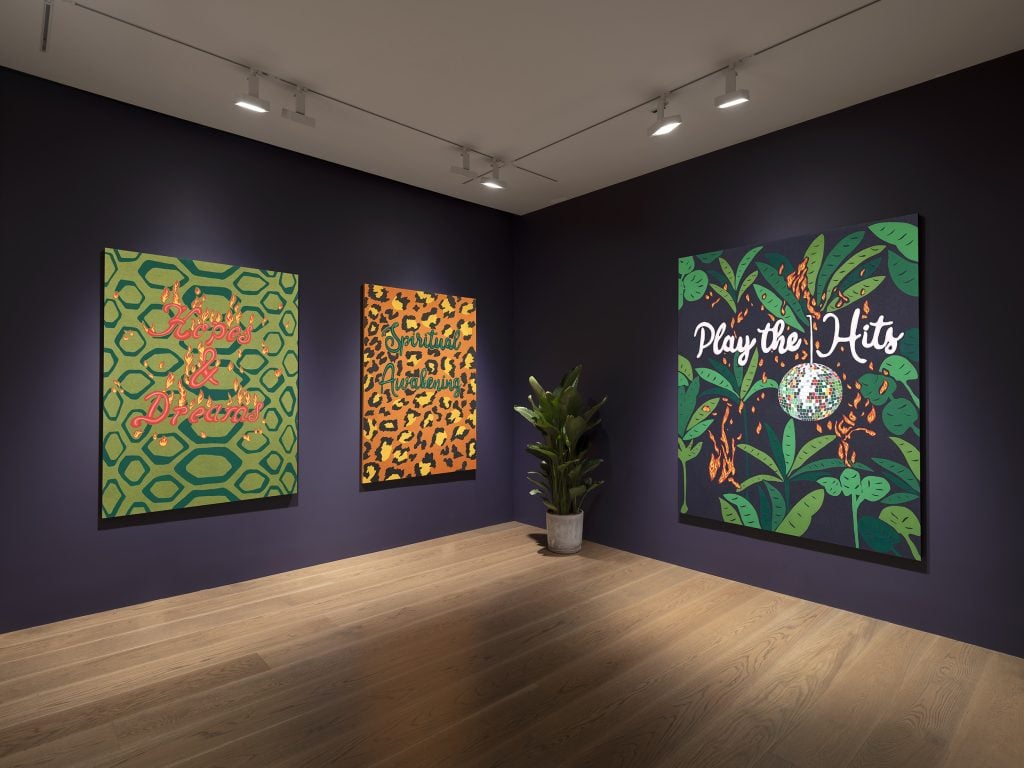
Installation view, “Joel Mesler: In the Beginning” at Levy Gorvy. Photo: Kitmin Lee, courtesy of Levy Gorvy.
What are your thoughts on the prices that your work has been fetching at auction? In April, you cracked the $200,000 barrier for the first time at Sotheby’s in Hong Kong against an estimate of $25,000 to $35,000.
It’s crazy. I guess people really want it. It’s important to keep everything in perspective. As much as you may have multiple bidders on a painting, there could come a time when you don’t. I’m doing the only thing I can do, and can control, and that’s keeping my head down and making the best paintings I can. Maybe that’s something I learned too as a dealer; not to get too ahead of myself and keep things in check a little bit.
A large chunk of the audience for your work, especially on the secondary market, is coming from Asia. What do you think is driving the demand for your work in that part of the world specifically?
I think that post-COVID, there was an art audience that was essentially trapped in Hong Kong, and they were so hungry for art, and for stories. From what people have told me, the audience in the region really responds to the storytelling that happens in my work. I made a painting in the show that says “good vibrations” or “good vibes.” I want to give goodness out into the world and I think that resonates.
Luck and timing have a lot to do with it. The fact that my exhibition happened in Hong Kong when it did got a lot of people excited. I feel I’ve been very embraced by that region but I couldn’t tell you exactly why that’s happening. What I can tell you is that I can’t believe how vast it is there. As an art dealer, I was never aware of the diversity. There are collectors in Korea, Taiwan, Hong Kong, Tokyo. It’s coming from so many places that it’s hard to make a comparison to New York in the ‘80s or whatever. It’s its own thing, and maybe it’s a new paradigm that is going to drive the global market. But again, what do I know?
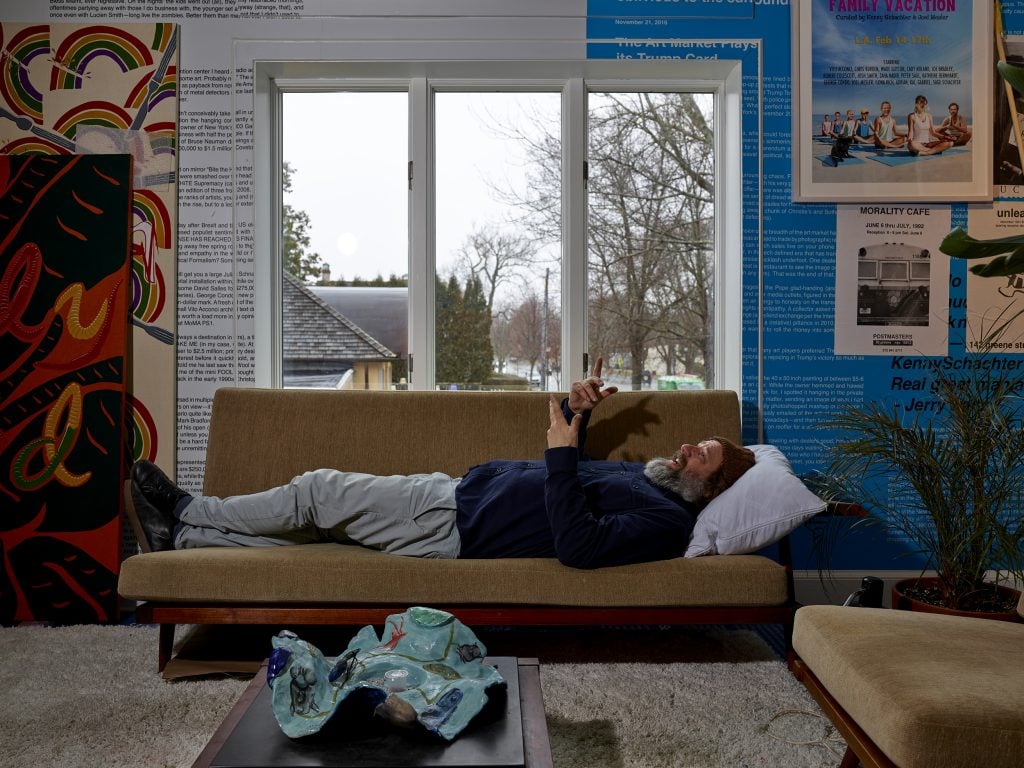
Joel Mesler in his studio. Photo Matthew Herrmann.
When I saw the announcement that you were having a show in Hong Kong, what came to mind is that you’re going where your audience is. Do you think that pragmatism has to do with your background as a dealer and a residual desire to make a deal?
I didn’t choose that region, it was chosen by Lévy Gorvy. They have spaces in New York, London, and Hong Kong, and when they approached me, they really felt that Hong Kong was the best place. Part of it is that in Asia, nobody knew me as an art dealer because I really wasn’t selling to collectors in Asia at all. I still have people that don’t take me seriously as an artist and think of me as an art dealer in America, especially in New York.
I’m not consciously staying away from New York, but my studio is outside of the city and I don’t really go to openings anymore. I’ve removed myself from the city where I was out every night as an art dealer, and where I was involved in many deals as an art dealer, so it’s interesting to show my work in cities that were outside of my purview.
We decided to do the show in Hong Kong way before any of the auction stuff happened. I also think that Lévy Gorvy really did an amazing job informing and educating their collectors, because they weren’t very familiar with my work. By doing the show [in Hong Kong], a lot of people came to the work and maybe that helped drive the market there.
What are the differences and similarities between being a dealer and an artist?
The art world is incredibly small and incredibly big at the same time. I see a lot of the same people as an artist that I did as a dealer. At the end of my art-dealing career, I felt there was a changing tide with emerging dealers. The world we are in now is very different than it was five years ago; I feel the same way as an artist.
How have the two paths changed since you started?
Globalization and the way art dealers maneuver in this global market is so different. Galleries are adopting sharing models like Condo, and also [virtual] things like David Zwirner’s Platform. The Leo Castelli model seems harder and harder to maintain, while the Gagosian model seems to be winning out.
And as an artist I literally couldn’t tell you, because I didn’t really have a before, I only have now. But when I first moved to L.A., [artist] Jon Pylypchuk would literally be selling drawings out of his backpack for $100 while we were standing in line at LACMA. The numbers are different and the way that art gets distributed is different.
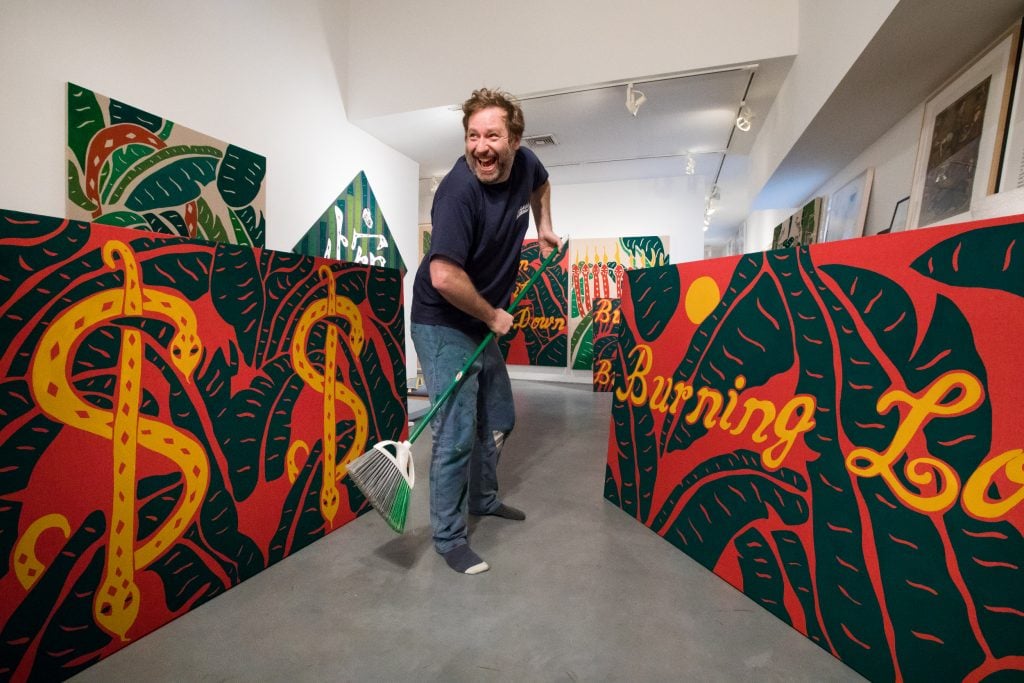
Mesler with his new paintings, 2020. Photo: Jenny Gorman Photography.
Do you still sell art? Would you switch sides again?
I had a very interesting situation where a few really good collectors wanted to buy the work of an artist I showed in my last exhibition. I was about to send the invoice, but decided not to. I put the collector and the artist in touch and had the artist send the invoice herself. I told them I do not want any of the money, and that I’m retiring my invoicing system. That was six months ago. I hope they get along and I hope the purchase went smoothly. I stepped away from that. I was ceremoniously retiring my art dealing jersey.
So you’re officially a painter?
I’m a painter as long as they don’t take it away from me, I guess. As it turns out, life is long.
Do you have any words of advice for art dealers secretly painting in their basement?
The “one day at a time” philosophy is the thing that’s carried me to this place. That may be the makeup of the entire practice at this point. It’s just one day at a time. I got our call today, I’m working on a painting, and then I’ll see my family at five. That’s all I got.
Follow Artnet News on Facebook:
Want to stay ahead of the art world? Subscribe to our newsletter to get the breaking news, eye-opening interviews, and incisive critical takes that drive the conversation forward.
